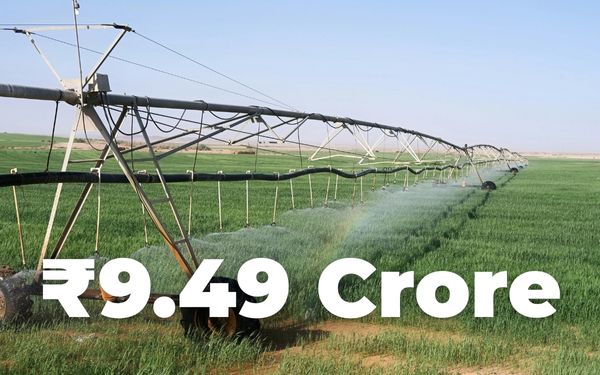1.Pradhan Mantri Kisan Samman Nidhi (PM- KISAN)
This scheme is for farmers with marginal income, it helps in giving financial assistance to the farmers to support their livelihood and also to procure any sort of necessary agricultural inputs.
Its main objective is to reduce dependency on informal loans from moneylenders. Also, to provide financial benefits to the small-scale farmers.
Benefits
Guaranteed annual income of Rs 6000 per year, farmers will get a direct benefit transfer, which helps in avoiding any leakages and middlemen. The amount will be paid in instalments, 3 times a year. With the help of this scheme, farmers are encouraged to do farming and avoid informal loans from moneylenders, hence helping in avoiding unnecessary loans and most of the necessities are covered by this scheme for marginalised and small-scale farmers.
Eligibility
This scheme is for every farmer in India who owns cultivable land, they need to present the documents of the land while registering, which will ensure that every family gets the benefits.
Excepts- any government employee, professionals like doctors, engineers, lawyers, etc, any current or former constitutional post holders, elected members of parliament, assembled.
How to avail of the scheme
1- You can apply to this scheme by visiting the nearest common service centre or the state agriculture office.
2- can directly apply through this portal: https://pmkisan.gov.in/
2. Micro Irrigation Fund (MIF) – PMKSY
With the tag line of “More crop per drop”, the Micro irrigation funds scheme was launched in the year 2018, operational under the “Pradhan Mantri Krishi Sinchayee Yogana”. Its main goal is to promote efficient water usage in agriculture and tackle water scarcity challenges in various villages in India.
Objective
The main objective of this scheme is to promote micro irrigation technologies, as in this world of climate change, and increasing demand for agricultural produce, we need agriculture and also a lots of water supply which isn’t readily available for some areas, hence inorder to tackle water scarcity, there are new technologies but adapting to it takes time for the farmers, thus government has introduced this scheme so that farmers can adapt to new technologies.
- It provides low-interest loans to the states for micro-irrigation projects.
- Funds allocated are Rs. 5,000 crore
- This is part of the PM Krishi Sinchayee Yojana, managed by the National Bank of Agriculture and Rural Development.
Benefits
Helps farmers to adapt to newer technologies in water irrigation systems, reducing water use by 30%-50%. As there’s no unnecessary wastage of water, hence an increase in efficiency, conserves water and minimises fertiliser/ pesticide runoff.
As farmers, you will get a loan and financial benefits under this scheme.
Eligibility
Farmers, who own lands, self-help groups, and cooperatives. Basically, anybody who has farmland or wants an irrigation system can avail this scheme.
How to avail of the scheme
Can apply for this scheme by visiting the District Agriculture Office or the Krishi Vigyan Kendra (KVK), or can directly apply by filling the form under PMKSY to drop more crops.
3. Agri Infrastructure Fund – Atmanirbhar Bharat
It was launched in the year 2020 under “Atmanirbhar bharat”, its schemes give financial support to the farmers and farming communities to build infrastructure, such as warehouses, cold storages, farm machinery banks, irrigation facilities, solar systems, etc. Its main focus was to improve farmers’ income by better availability of infrastructure.
Benefits
Under this scheme, the government of India will provide financial assistance, with a Rs. 1 lakh crore fund for medium—to long-term debt financing. There will also be a 3% interest subvention per annum on loans up to Rs. 2 crore for 7 years. Credit guarantee coverage will be provided through the credit guarantee fund trust for micro and Small Enterprises (CGTMSE).
Eligibility
Anybody can benefit from this scheme, including farmers, agripreneurs, communities, etc. You can avail yourself of this scheme if you are looking for any post-harvest infrastructure, community farming assets.
How to avail of the scheme
In order to avail of this scheme, one can visit the local agriculture department’s office, mainly in the blocks of a village. Or can also visit common service centres.
Can apply through an online process, visit the official portal, register as an eligible entity, submit all the necessary documents and apply for loans through the portal linked banks and NBFCS.
4.e-NAM (National Agriculture Market)
This scheme was launched in the year 2016, its main objective is to create a unified digital marketplace for agricultural commodities by the government of India, under the Agricultural Produce Market Committee (APMC).
This scheme doesn’t provide any sort of financial assistance like other schemes, but it provides a marketplace where farmers trade their produce across different states. Its main goal is to eliminate middle middleman and ensure reasonable prices.
Benefits
Farmers can connect and trade with other buyers across states, no middlemen will be involved. Better prices for the farmer for the produce.
Reduce dependency on local agents to sell the produce. Payments are made directly to the farmer’s bank account. This type of online platform gives the farmers a brief idea about the prices in the market, can also access the historical data for better decision making.
Quality check, weighing and grading services are integrated.
Anybody (farmers and traders) who has produce to sell is eligible for this scheme.
How to avail of the scheme
Farmers can apply for this scheme by visiting the nearest e-NAM registered mandi/APMC, or can apply online at https://enam.gov.in submit the necessary Once verified, you can view real-time prices, also post your produce for sale and receive bids from traders.
5. Rashtriya Krishi Vikas Yojana – RAFTAAR
RAFTAAR- Remunerative approaches for agriculture and allied sector rejuvenation, was launched in 2007, to support and strengthen the agriculture infrastructure. Under this scheme, it financially supports states for their agricultural plans. Its main goal is to promote agri-entrepreneurship and good infrastructure for agriculture.
Benefits
This scheme funds the states to invest in agricultural projects such as agribusiness incubation, startup funding, and skill development.
These investments will further help farmers and agripreneurs to increase productivity and income.
All the funds are allocated for the modernisation of agriculture, innovation, and smart technologies in agriculture, which will help increase the production and productivity of agricultural activities.
Eligibility
Startups, individuals and state governments are eligible for this scheme. Anybody who wants to avail of this scheme needs to present the necessary documents and agricultural plans.
How to avail of the scheme
In order to avail of the scheme, you need to prepare and submit the business proposal document after you have applied through recognised RKVY- RAFTAAR agribusiness incubators. You will receive funding in phases upon successful evaluation.
6. National Mission on Sustainable Agriculture (NMSA)
Under this scheme, subsidies and financial assistance are provided for climate-safe agricultural projects. This scheme focuses on promoting sustainable agriculture practices in order to improve soil health, water scarcity in agricultural activities.
Benefits
This scheme will help farmers who face losses due to climate change. By providing subsidies in climate smart technologies, soil health, irrigation, water harvesting systems, organic farming, precision farming, compost units, etc.
Subsidies are provided, up to 55% for small and marginal farmers and 45% for other farmers.
It also supports farm-level infrastructure, rainwater harvesting and agroforestry.
Eligibility
Farmers, NGOS, farming communities, farmer producer organisations, etc.
How to avail of the scheme
You can avail of this scheme by contacting the nearest agriculture block office or the state agriculture department.
7. Soil Health Card Scheme
This scheme was launched in 2025 by the Ministry of Agriculture and Farmers’ Welfare. Its main objective was to educate farmers about their soil health. Each farmer gets the soil health card, which contains information regarding the health of the soil (the nourishing status of the soil), crops that can be grown in that specific soil type and also recommendations on usage of fertilisers in order to improve the health of the soil.
Benefits
Farmers get a brief idea about their soil’s health, even though farmers are already pretty much well aware of their soil type, but due to the popularity of chemical fertilisers, the soil’s health condition tends to deteriorate in the long run.
This scheme helps farmers understand the accurate usage of fertiliser and organic matters, which can be used to improve their soil health.
This will help in more yield, low input cost.
Eligibility
This scheme is available to all farmers in India irrespective of location, land size, etc.
How to avail of the scheme
In order to avail of this scheme, you need to visit your nearest agricultural block, common service centre, or local krishi vigyan kendra.
8.Paramparagat Krishi Vikas Yojana (PKVY)
It was launched in 2015 under the Ministry of Agriculture and Farmers’ Welfare. Its main objective is to promote organic farming, reduce the usage of chemical inputs, improve soil degradation, and increase the productivity of the farmers.
Benefits
Farmers will get financial assistance of Rs 50,000 for 3 years, which can be used for organic input procurement (Rs 31,000), certification and documentation (Rs 14,500), training, exposure visits and marketing (Rs 4,500).
Farmers will also get access to premium organic markets, packaging, branding and marketing benefits.
Eligibility
Farmers (group of minimum 20 members), self-help groups, farmers producer organisations, etc., each farmer should have 1-2 hectares of land.
How to avail of the scheme
As an individual, you need to join a certified group.
As a group, you need to form a group of 20 members with at least 1-2 hectares of land each member. Then submit the application to the state agriculture department or district nodal agency. Undergo training and practice organic farming, then receive certification under the PSG India.
9. Pradhan Mantri Fasal Bima Yojana (PMFBY)
This scheme was launched in 2016 by the Ministry of Agriculture and Farmers Welfare.
Its main objective is to provide crop insurance coverage, which will help them financially from risks such as natural calamities, diseases and crop failure.
Benefits
Provides insurance and financial support to farmers in case of crop failure.
This helps farmers to have a stable income irrespective of crop losses due to any natural calamities, pests and diseases.
Promotes farming and also helps farmers to experiment with new and innovative technologies.
Farmer’s share of premium is 2% of the sum insured in case of kharif crops. 1% of the sum insured is the farmer’s share of premium in case of Rabi crop.
Eligibility
All farmers can apply with their land documents.
How to avail of the scheme
You can avail of the scheme by visiting the nearest bank branch or, CSC centre.
10. National Mission on Sustainable Agriculture (NMSA)
It was launched in 2014 under the Ministry of Agriculture and Farmers Welfare, as a part of NAPCC.
This scheme promotes sustainable agricultural practices. Sustainability is a really hot topic from the past few years, as people have started facing the effects of climate change, which makes sustainable practices a priority. It aims to increase the efficiency of agricultural activities, while climate change is not a side effect or byproduct.
Benefits
Climate-smart agricultural practices are adopted as they not only protect soil from degradation, less water wastage, but also help agriculture in the long run.
Provides financial assistance for water harvesting systems, irrigation systems, soil health management, and agroforestry development.
Eligibility
Any farmer, self-help groups, and farmer producer organisations are eligible. Main targeted areas are rainfed/ drylands regions, areas with declining soil fertility, groundwater levels, floods and droughts.
How to avail of the scheme
Visit local agriculture offices, block, KVK- Krishi Vigyan Kendra. And submit necessary documents and register, select the area you want to apply and use the benefits of the scheme.







